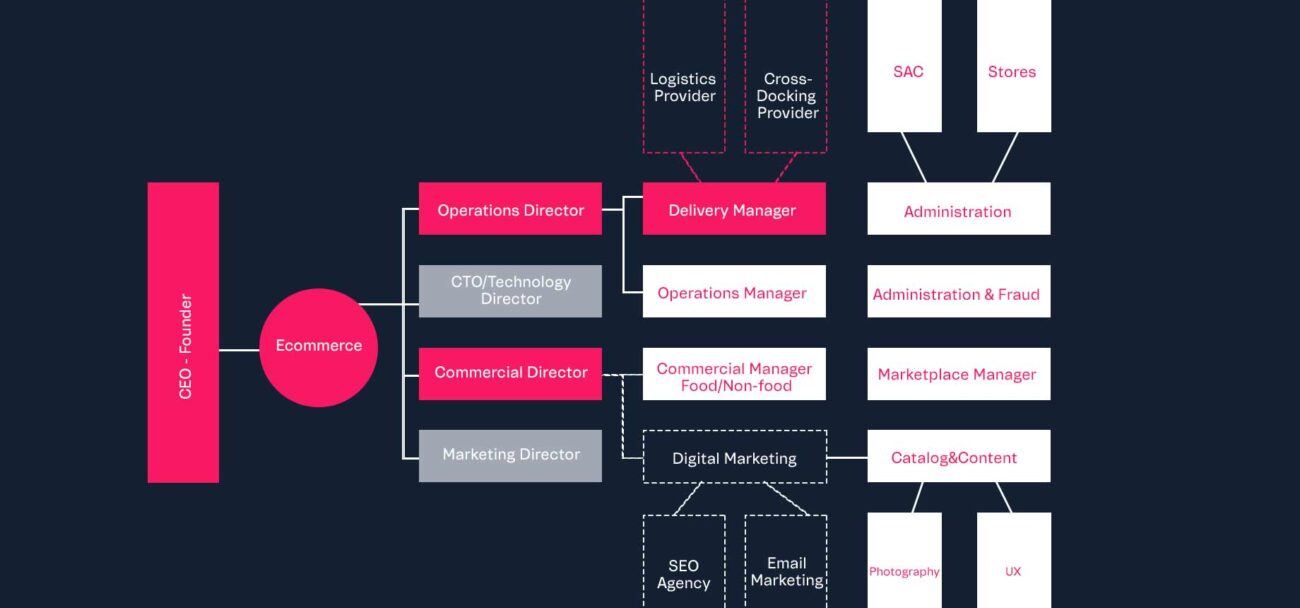
I am back with the final part of my blog series on how to build your grocery ecommerce team. After Part 1 delved into some foundational aspects and Part 2 sketched some possible chain of commands inside the organizational structure, this last article will focus in detail on the different sub-areas, key roles, job descriptions and KPIs a grocery ecommerce team should embody.
Buckle up and take notes — we’re not leaving any stone unturned.
The CTO is a key player in the area, since they are responsible for the technology solution. The solution they are in charge of must be safe, scalable, have good performance (both technically and in terms of economical efficiency), while also being lean and flexible.
The CTO is the orchestrator of this business demand, generating the team necessary to respond to this demand. Some special focus in the food/grocery sectors for the CTO would be:
Whether “to build or to buy” and to solve the “1st-party vs. 3rd-party web developers” dilemma are some of the decisions they have to make.
The product manager will drive the company’s technology stack evolution and prioritization. They will focus on the customers’ needs in order to transform the digital assets of the company into a kind of product, bringing value to clients.
They usually manage the backlog prioritization, especially in grocery segments. Why? Because in this sector low margins mean a small budget and a long backlog, so prioritizing key projects and initiatives becomes crucial, and it is very important that they can articulate that roadmap with the business and SAC teams.
Their KPIs are usually product fit, time deviations and the impact of their projects on business KPIs. For example, if an improvement in performance for implementing a PWA increases conversion rate by 5% and gross income rises.
Front-end developers can be from a third party or in-house (i.e. first-party). They will manage the User Experience (UX), design and performance of the online store (website and/or apps).
Their focus is on performance and usability, and they should have KPIs of rendering time improvement, best practices scoring and many other indicators that can lead to better conversion, and therefore more sales.

As many other positions, back-end developers could be in-house or 3rd-party from specialized tech agencies. They are in charge of the development and maintenance of the system architecture, especially between the legacy systems and the cloud services needed to sell online.
If you were wondering, yes, their concerns are related to performance, but mostly focused on uptime and availability, and on data consistency across all systems and client experiences. They also have to tackle the online and offline system integrations, which is usually a great challenge, and unify all the clients’ points of contact and points of sales with the company. This includes everywhere shoppers are buying groceries online: proprietary channels like apps and websites, or 3rd-parties like marketplaces or last-mile delivery companies.
These analysts are the ones responsible for testing and debugging all the solutions before they can be launched to end-consumers, in order to assure minimum disruption. Often, they are also translating business requirements to specific technical requirements.
The Commercial team is often led by a Commercial Director. They are the ones responsible for all of the company’s sales, including online grocery sales. Their focus is on product sales and distribution, pricing on good but competitive margins (benchmarking is crucial on this matter), and managing the sales demand by discount and price dynamics.
Their key KPIs will be gross sales and they will have a special interest in the digital penetration of the company, looking into profitability as it grows. Also, planning for big events is crucial for the Commercial team, since they consolidate anywhere between 20- 40% of all the year’s sales (depending on the country), and even more if you add holidays.
It is very important for the commercial area to interact with IT, mostly by prioritizing and defining needs vs. possibilities, as well as with the Marketing and Operations Teams. At all times, taking into account the customers’ experience will be a great driver for customer retention and organic sales, the holy grail of ecommerce.

It goes without saying that catalogs are a huge part of the ecommerce business. From searchability, content enrichment, category management, product comparisons and reviews, images and audiovisual content within the online shopping experiences, all those tasks fall inside the Catalog team’s responsibility.
For them, the major driver and KPI remains SEO. The catalog leader should closely keep in touch with the commercial team, both executing the commercial strategy and also bringing insights of out-of-stock or no-availability items, user searches, and products with huge visibility and conversion rate.
They should also interact with the Marketing team to take those insights into the upper funnel tactical approach. Of course, SEO is a fundamental and shared responsibility for both areas, since the Catalog team will mostly manage on-site SEO and Marketing off-site SEO (i.e. referrals, backlinks and content generation).
Category managers handle the product portfolio of an ecommerce site and of other channels/point of sales, each with their own category. They are responsible for product enrichment (i.e. descriptions, keywords, tagging, structured attributes, searchability, reviews, ERP/PIM product sync, etc.) and have a crucial role in marketplace business models.
In those scenarios, the category managers have a partly commercial role, which depends a lot on how you structure the team. Bottomline, they will actively look for and sign deals with new sellers, in addition to maintaining relationships and acting as focal point within a specific category (e.g. electronics, toys, fashion, etc.).
They usually have a KPI regarding the number of sellers and SKUs on a given category, since the more alternatives you offer to your users in a marketplace, the more the conversion rate usually increases, as customers are more likely to find what they are looking for in the store. They sometimes even have the liberty to adjust marketplace fees and/or prices in case of 1st-party category management (i.e. stocking directly from suppliers).
Content managers can be both on the commercial or marketing side, depending on the company approach to content. As a rule of thumb, companies with high margins or commoditized products often put a lot of effort into brand positioning, and in those cases they usually end up in the marketing area, focusing more on brand awareness/strength than on performance.
For companies with lower margins like in the grocery industry, content is expected to be much more performance-oriented, therefore depending on the commercial area. A perfect example of performance-oriented content is how grocery retailer Jumbo uses recipes to improve the average item per order, and therefore average order value (AOV). Grupo Exito’s use of Live Shopping is yet another way to combine content with sales.
The content team is responsible for managing the way a brand, company or retailer speaks to their current and target consumers. They should learn who these consumers are, what their preferences, characteristics and insights are, and ultimately generate interesting and action-driving content inside and outside their digital channels. They should cover everything and anything from a social media standpoint and email marketing to the company’s website or app and even 3rd-party content.
This role also implies a lot of content enrichment for the catalog team mentioned above and, depending on the team’s size, all responsibilities could be condensed in one single person.

Search team members and teams, although in initial phases are not so crucial when compared to other areas that accelerate growth, are of extreme importance for big retailers and ecommerce operations. Search is one of the best ways to improve conversion rate and capitalize on the site’s and app’s traffic. For instance, a client’s migration to an AI-powered search increased conversion by 42%.
The team’s responsibilities are ensuring the right SEO structure, preventing catalog errors, reducing the unavailable or stock-out product searches, managing internal redirects in order to prevent users from not finding items for their specific needs. This will mean also translating business needs to internal search results by applying merchandising, synonyms, substitutes, commercial and relevance rules into the search engine.
Marketing teams can have many different approaches, and their origin inside the company can be either in-house or third party, performance- or brand-oriented (as explained above).
In almost all scenarios, there usually is a Marketing Manager, a digitally-trained marketing specialist that can have a 360-degree and full-funnel view and methodology over the operations. Their main KPIs are managing the company’s ROAS and ROI and driving qualified traffic into the company’s digital assets. This will mean managing SEM and SEO campaigns, Social Media Marketing (SMM), Press & Public Relations (PR), physical store and omnichannel marketing efforts, and so much more.
The Performance team’s main goal is to optimize revenue streams generated by digital marketing efforts, especially but not limited to paid media, thus maximizing sales efficiency. This will mean having conversion rate as the “pulse” of their campaigns, and how quality traffic drives interested and engaged potential customers through relevant and specific advertising.
On this matter, there is value in having specific digital marketing agencies from which the team can learn and obtain support in performance management. Why? Because digital media trends and rules change so much and so often that it is very difficult for internal teams to “keep up” with everything. These performance-oriented agencies (never get a branding-oriented digital agency for these types of jobs!) are constantly updating their knowledge and experiencing them first hand with many other clients.
No matter if the team collaborates with such an agency, ROAS and ROI should be important KPIs and the team should manage specific KPIs for each part of the funnel. For example, conversion rate is not a metric you should use for upper funnel campaigns, because you are working on brand or product awareness.

The Communications team is responsible for structuring and communicating the company’s value proposition, values, language, tone and key messages across both proprietary or third-party channels or touchpoints. It is in close contact with both Press and PR to augment brand awareness and also to generate content, with the main difference being that the Communications team focuses more on content they cannot control, but rather only influence.
Their KPIs are mainly related to reach and brand awareness, with big companies having a further divide by internal and external communications, depending on the relative importance of their employees. In many cases, these roles are outsourced, or merged with the general communication department.
My only advice here is that these professionals should be trained and updated on digital trends and digital marketing, otherwise they won’t have a positive impact on the digital strategy.
This team is responsible for defining the set of options a (potential) client is offered to pay through when in a digital commerce environment, and also for managing payment conditions such as installments, period of cancellations and return policies. They have an impact on conversion rate and net revenue, so it is vital that they have a close communication with the Commercial team, since, for example, in countries where there is high inflation, like Argentina, financing installments is a great sales driver.
Most importantly, however, they manage risk: they measure approval rate vs. fraud rate, meaning the amount of payments the company approves vs. the amount of money it loses when fraud or debt intervene. This is so common and consistent across countries and industries that ecommerce has a specific line on its P&L accounting for the money loss generated by these concepts, which can amount to more than 1% of the gross revenue.
Therefore, they are also trained into applying different anti-fraud processes and technologies in order to detect and prevent fraud scenarios, minimizing the impact to the approval rate. Sure, cancelling any suspicious transaction would be fairly easy, but it would heavily and negatively impact the revenue of the ecommerce channel, lowering the approval rate and implicitly the net revenue.
The Operations department will generally manage ecommerce processes, mainly focusing on stock availability, product substitutes, fill rate, preparation SLA, billing and everything related to getting the right products ready for the logistics teams to deliver.
They are being examined by fill rate (i.e. out of stock – quantity of replaced items) and are in continuous touch with both Customer Support (especially for the product substitutes and replacement processes that are very common in grocery) and Logistics. Depending on the company’s approach, the head of the area could be inverted, with Logistics sitting inside of Operations, or vice versa.

Pickers have to get out there and prepare the products the client bought online. In grocery, they are very important, since automated picking processes are very rare. Indeed, think of low-margin products with high rotation and a wide assortment, with dozens of selected items per order — companies will most likely not be able to fully automate the substitution process.
Thus, with the help of different picking techniques (e.g. pre-picking waves, mono-picking, multi-picking, etc.) they have to assemble the order and leave it ready to go for the Logistics team — or the customer themselves, in case of pick-up in-store (i.e. click & collect) or curbside pickup (i.e. drive-through).
Their KPIs are concerning picking efficiency, such as time per picked order, or time per picked item, although there is a lot more refinement to be done on this matter.
This team usually receives the order from the picker and does the invoicing process, which can be manual or automated depending on the size and maturity of the operation. They also manage payment conciliation, partial or total refunds of returns and reverse logistics inventory. The latter happens only when applicable, because depending on the country laws, many online food purchases are not available for return, since they have an expiration date and are prone to instant-consumption.
Their success is measured by SLA, and it also covers the conciliating process of all payments, throughout different payment methods.
The Logistics team is the ecommerce industry’s Wizard of Oz (minus the wicked part). They are not usually “seen” by the end-consumer, yet a huge part of the company’s profitability, the customer’s experience and even the gross sales depend on them. They mainly manage inventory — planning, stocking, distributing and delivering — trying to make the products reach their clients as fast as possible and at the lowest possible cost and without them breaking or disappearing in the process.
They function based on a logistic SLA metric and also an inverse logistic metric (which actually involves many other areas). They are also concerned with time efficiencies like dock-to-stock and other inbound and outbound logistics metrics.
It is extremely relevant for the Logistics and Technology teams to be aligned, since having a near-real-time online stock that can reflect the whole warehouse network of the company (i.e. multiple distribution centers or warehouses and also physical stores that allow picking from their inventory) is fundamental to reducing logistics’ cost and time. After all, we are in the age of same-day delivery, with Amazon Fresh posing a serious threat to grocery retailers.
This grocery logistical complexity is solved by comparing the customer’s geolocalization with that of the inventory, understanding which stock should supply that user’s demand and adjusting the site’s assortment to available stock.
Next, a decision to be made — not an easy one — is whether to have an in-house logistics fleet or outsource the service. The decision will be influenced by the local companies’ service offerings, but in my experience, grocery chains tend to use hybrid models. Usually, 3rd-parties supply electronics and high-volume products, whereas 1-party fleets cover the food process, since it calls for a fast SLA and involves short distances and even scheduled delivery.
Logistics is without a doubt a key part of any grocery ecommerce’s success. In fact, VTEX’s CEO and Co-Founder Mariano Gomide named Logistics as the Primary Marketing Instrument, putting into perspective the effect it has on the whole client retention process.
An important aspect to highlight is that customer service interacts with customers and potential customers to ensure a positive purchase and post-purchase experience, therefore driving customer retention and brand loyalty.
Consequently, a CRM team, coupled with proper processes and systems, are very relevant for organizing consistent, fast and resolution-oriented responses to customers and prospects around every touchpoint. So, although the ecommerce world brings new variables to the table in comparison to traditional physical sales, companies should make the effort to unify their customer support teams if they previously had them divided in on and off teams.
Their KPIs could be measured by NPS of different client satisfaction methods, and also have purely operational KPIs on first-time response (FTR) or Full Resolution Time (FRT), for any issue brought by the customer.

The Data Analytics team is often in the marketing department, looking after performance results and insights, but many companies are starting to have a much broader perspective on where to apply this analytical capacity.
Mainly, modern companies aspire to have a data-driven approach, and this team’s goal is to do exactly that: mapping and digitalizing all of the company’s processes and, through a unified technology approach, turn data into information. This will in turn enable different teams to transform that information into actionable insights. The company can improve using insights regarding its own mistakes and successes, and even those of competitors.
You can think of it as a service area, but on a very strategic level, articulating the correlations between the actions and effects of the different areas and teams.
Since many companies, industries and countries have different approaches to organizing their teams, this list could be endless. I would just like to point out that the Ecommerce team, no matter its shape or size, is always supported by other teams such as Legal, Finance or HR.
We’re finally at the finish line! So, let’s recap the main topics of all three parts (here are Part 1 and Part 2 for a memory refresh), as there was a lot to take in.
In a very concise to-do-list, here are the steps you should take for building a successful grocery ecommerce team:
Last but not least, if you came in here looking for a top-down, only-one-possibility definition of an ecommerce team, you are probably feeling a little disappointed right now. Don’t worry, though! With the risk of being a crude reductionist, I will leave you with a practical example of how a grocery ecommerce team could look like — but if you have any further questions, don’t hesitate to reach out.


